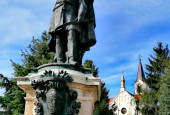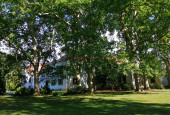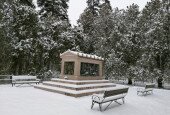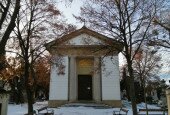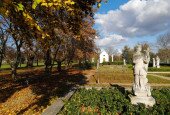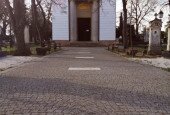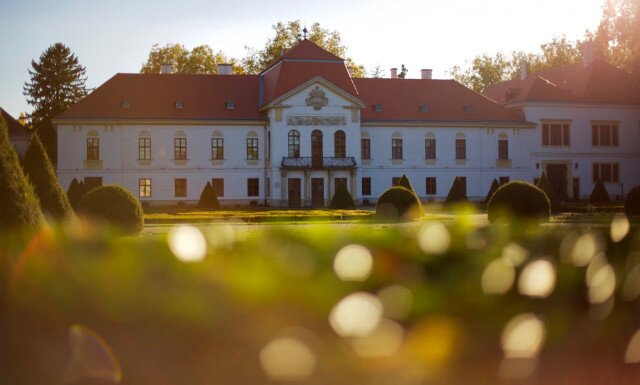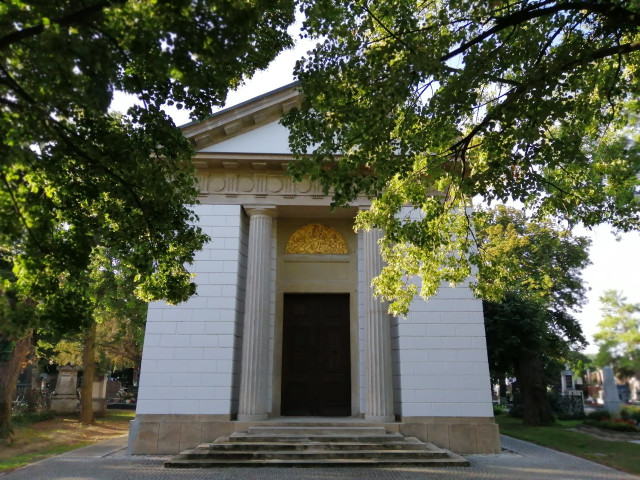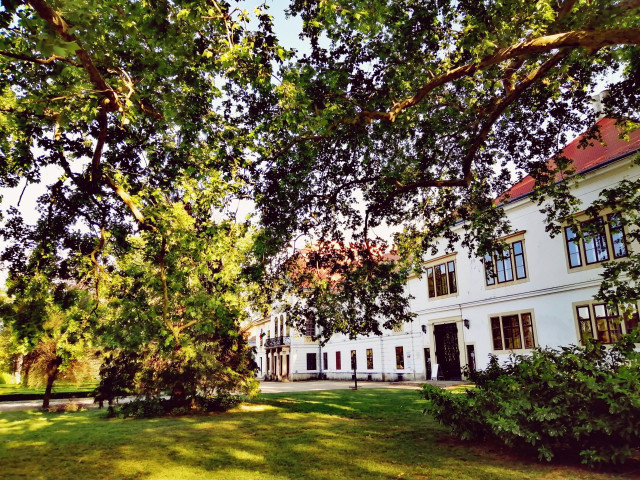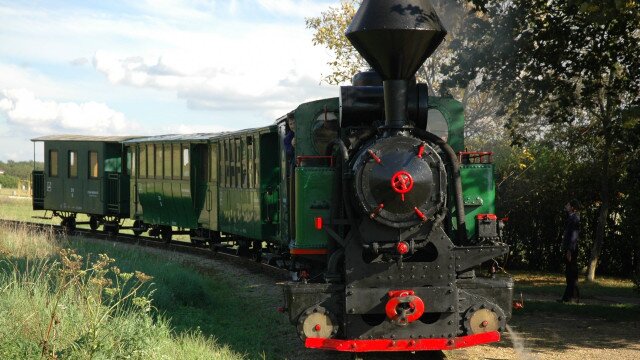Nagycenk
The village in the valley of the Ikva and Arany brooks was first mentioned in documents from 1291, and in later sources it is mentioned as two separate villages. In the Middle Ages it was owned by the families of Kanizsai and Nádasdy. The former Nádasdy mansion in the village centre later became the White Horse Inn. The village was owned by the Széchényi family in the 17th century in the time of Archbishop György Széchényi, and in the middle of the 18th century, with the construction of the main building of the present palace, it became the family's manor centre. The history of the town is firmly attached to the history of the family and to István Széchenyi, who inherited Cenk from his father, Ferenc Széchényi. The two parts of the village were united in 1892 with the name Nagycenk.
Attractions:
Széchenyi Palace: In Nagycenk you can find the central main building of today's palace ("Old Palace") and the ornate French garden that was built in Baroque style in the 1750s during the time of General Antal Széchényi and his wife Zsuzsanna Barkóczy.
After the death of Antal Széchényi's widow, Ferenc Széchényi took over the estate centre and rebuilt it in Classicist style, and he also created the English park around it. Here he stored his collection of valuable books, manuscripts, minerals, and a part of his medal and map collection, which he offered for the benefit of today's Hungarian National Museum and the National Széchényi Library in 1802. In 1820 István Széchenyi inherited the palace and extended the building complex with side wings connected to the central building at right-angles (the eastern Riding School and the western Széchenyi Wing).
In the west wing the first bathroom Hungary with a circular pool that is suitable for having a shower, and an English-style flush toilet were made, and the palace garden was given gas lighting.
During the time of his older son, Béla Széchenyi the English park was completed with many plant rarities from his expeditions in Central and Eastern Asia.
After World War II, the abandoned palace nearly fell into despair its furnishings were dispersed. After the completion of the renovation works that were going on for more than two decades, the Széchenyi István Memorial Museum was opened on 21. September 1973, in the middle of the building complex, the so-called “Old Palace”. Still, renovations were not fully completed in the palace. The renewal of the eastern wing of the palace complex and the former stables followed and then the exhibition area was further expanded in 1985, when the Széchenyi wing was renovated.
From November 2014, the Eszterháza Cultural, Research and Festival Centre took over the management of the Széchenyi István Memorial Museum. The ground-floor halls of the exhibition present the history, ascension and the prominent persons of the Széchényi family as well as the life of István Széchenyi. The interiors, furbished with furniture, paintings and documents of the period evoke the atmosphere of a 19th-century palace. Baroque stairs lead to the first floor, where several documents, models and miniatures invite you to learn about the practical works of István Széchenyi. The palace, the palace park and the Linden Alley have all been part of the Fertő Area World Heritage Site since 2001. The palace park and the Linden Alley are among the historical gardens of Hungary and they are also a nature protection area.
During the reconstruction works taking place between 2020-23, the Old Castle, the Széchenyi Wing, the Flower House, the Pandúrházak, and the castle park were also reconstructed, and the exhibition presenting István Széchenyi as a statesman and as a private person was renewed. From December 15, 2023, the renewed castle will welcome visitors again.
Linden Alley: The first, Baroque plans of the park date back to the middle of the 18th century, to the time of Antal Széchényi. The palace is surrounded by English-style park sections on the west, east and south, which is attributed to Ferenc Széchényi and then his son, István Széchenyi. The expansion of the English garden was completed in the 1820s, and the creation in its present form is the work of Béla Széchenyi. Originally built as a riding path, the 20-metre-wide and 2,600 metre-long linden alley was an integral part of the Baroque garden along with the Baroque hermit’s chapel that once stood at the end of the alley. Today at the end of the linden alley, you can find the ornate red granite sarcophagus of Béla Széchenyi and his wife Hanna Erdődy, who died young. The palace park and the linden alley have both been part of the Fertő Area World Heritage Site since 2001. The palace park and the linden alley are among the historical gardens of Hungary and are also a nature protection area, managed by TAEG Forestry as part of the Sopron Park Forest.
Statue Park: To the east of Linden Alley, a statue park was established by local initiative to present public statues that were believed to have disappeared after World War II. It has several statues that are considered to be curiosities, such as the only public sculpture St. Tekla in Hungary. In 2020 the park right next to the Linden Alley that can be visited free of charge, was completed with the building of the baroque hermit's chapel renovated based on original drawings. The chapel was once at the end of the Linden Alley.
Museum railway: The museum railway that was established in 1972 by the Győr-Sopron-Ebenfurt Railway (GYSEV), has a 760-mm track gauge and a length of
House of Creation: The House of Creation is in the former bailiff’s apartment built in 1790 and is an important site for local events.
St. Stephen's Parish Church and Széchenyi Square: Miklós Ybl was commissioned with the preparation of the plans of the three-bayed, Neo-Romanesque church by István Széchenyi, who was already in Döbling. The bronze statue of István Széchenyi is the central, emblematic element of the square.
Mausoleum: Entering the cemetery gate, reading the timeless thoughts of István Széchenyi on the pavement you can get to the central building of the graveyard, the Széchényi Mausoleum. Both the mausoleum and the crypt bear the marks of their construction periods. The oval chapel and tomb, built by Zsuzsanna Barkóczy, was expanded in Classicist style on behalf of Ferenc Széchényi with a foyer built following the example of Greek churches and a crypt with a cross-shaped floor plan. In the mausoleum you can find in particular the earthly remains of Count István Széchenyi, the ashes of Count Ferenc Széchényi and the mummified body of Pál Széchényi, the Archbishop of Kalocsa. Currently 48 descendants of the family rest in the tomb.
Previous examinations identified arsenic on the skin surface of Pál Széchényi's mummified body kept in a glass coffin. The legend that the archbishop was poisoned was based on this. By nowadays it has been proven that the body of the archbishop was preserved with arsenic solution by the Pauline monks of Sopronbánfalva, and the body remained in such good condition due to that.
In 1910 it became necessary to expand the cemetery. In the centre of the new cemetery section, a new family crypt was created under a huge sarcophagus, where the ashes of the Széchényi descendants were placed from the Benedictine (Goat) church in Sopron as well as from the family crypts of the churches in Fertőszéplak and Egervár.
Currently, more than 100 members of the family rest in the cemetery garden.


